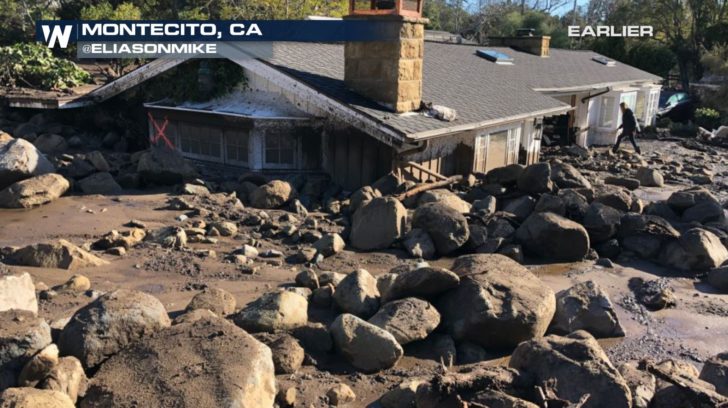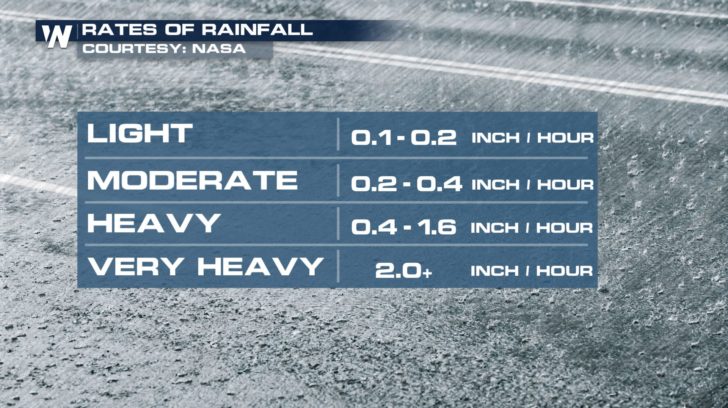Rain Rates vs. Storm Totals
Top Stories
8 Feb 2018 1:42 PM
https://www.facebook.com/WeatherNation/videos/10156232567654874/
When we talk about rainfall rates during a storm, timing and amount is everything.
"A half an inch per hour is the minimal guidance for debris flow and here we got a half an inch in 5 minutes," said David Gomberg, a meteorologist at the National Weather Service Los Angeles/Oxnard.
 Gomberg is referring to the historic rainfall rates that lead to catastrophic mudslides in parts of Southern California at the beginning of 2018.
"We saw rainfall rates that were anywhere from about four to even six times the rate that we could see for USGS threshold," Gomberg said.
Gomberg is referring to the historic rainfall rates that lead to catastrophic mudslides in parts of Southern California at the beginning of 2018.
"We saw rainfall rates that were anywhere from about four to even six times the rate that we could see for USGS threshold," Gomberg said.
 Rainfall rates measure the intensity of rain within a certain period of time.
That's different from rainfall totals, which are the overall amount of rain expected to fall during a storm.
https://twitter.com/NWSLosAngeles/status/951588431368421376
"When we are talking about rainfall rates of high intensity we are looking at those time scales under one hour," Gomberg said.
Rainfall rates can be measured by a combination of rain gauges and Doppler Radar.
"Typically on the order of hourly rainfall estimates and also instantaneous rainfall estimates we kind of use a combination of both of those with the rain gauges that kind of give us an overall picture of rain rates," Gomberg said.
Crucial information we need to know to determine if there is a threat for flooding or mud and debris flow in recent burn scar areas.
For WeatherNation, I’m Meteorologist Meredith Garofalo
Rainfall rates measure the intensity of rain within a certain period of time.
That's different from rainfall totals, which are the overall amount of rain expected to fall during a storm.
https://twitter.com/NWSLosAngeles/status/951588431368421376
"When we are talking about rainfall rates of high intensity we are looking at those time scales under one hour," Gomberg said.
Rainfall rates can be measured by a combination of rain gauges and Doppler Radar.
"Typically on the order of hourly rainfall estimates and also instantaneous rainfall estimates we kind of use a combination of both of those with the rain gauges that kind of give us an overall picture of rain rates," Gomberg said.
Crucial information we need to know to determine if there is a threat for flooding or mud and debris flow in recent burn scar areas.
For WeatherNation, I’m Meteorologist Meredith Garofalo
 Gomberg is referring to the historic rainfall rates that lead to catastrophic mudslides in parts of Southern California at the beginning of 2018.
"We saw rainfall rates that were anywhere from about four to even six times the rate that we could see for USGS threshold," Gomberg said.
Gomberg is referring to the historic rainfall rates that lead to catastrophic mudslides in parts of Southern California at the beginning of 2018.
"We saw rainfall rates that were anywhere from about four to even six times the rate that we could see for USGS threshold," Gomberg said.
 Rainfall rates measure the intensity of rain within a certain period of time.
That's different from rainfall totals, which are the overall amount of rain expected to fall during a storm.
https://twitter.com/NWSLosAngeles/status/951588431368421376
"When we are talking about rainfall rates of high intensity we are looking at those time scales under one hour," Gomberg said.
Rainfall rates can be measured by a combination of rain gauges and Doppler Radar.
"Typically on the order of hourly rainfall estimates and also instantaneous rainfall estimates we kind of use a combination of both of those with the rain gauges that kind of give us an overall picture of rain rates," Gomberg said.
Crucial information we need to know to determine if there is a threat for flooding or mud and debris flow in recent burn scar areas.
For WeatherNation, I’m Meteorologist Meredith Garofalo
Rainfall rates measure the intensity of rain within a certain period of time.
That's different from rainfall totals, which are the overall amount of rain expected to fall during a storm.
https://twitter.com/NWSLosAngeles/status/951588431368421376
"When we are talking about rainfall rates of high intensity we are looking at those time scales under one hour," Gomberg said.
Rainfall rates can be measured by a combination of rain gauges and Doppler Radar.
"Typically on the order of hourly rainfall estimates and also instantaneous rainfall estimates we kind of use a combination of both of those with the rain gauges that kind of give us an overall picture of rain rates," Gomberg said.
Crucial information we need to know to determine if there is a threat for flooding or mud and debris flow in recent burn scar areas.
For WeatherNation, I’m Meteorologist Meredith Garofalo
All Weather News
More